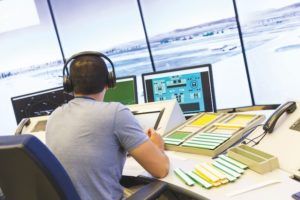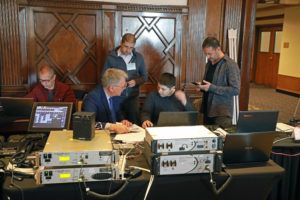Words by Paul Willis
The way pilots, air traffic controllers and others involved in aviation talk is changing thanks to the development of international standards and a push from component manufacturers.
The principal protocol for online communications is Internet Protocol. This set of rules is foundational in how the internet works. But despite its widespread use throughout the world, until recently IP has played little part in communications within the aviation sector.
Recently there has been a push at the international level to migrate air traffic communications to an Internet Protocol (IP)-based system, referred to generally as the Internet Protocol Suite (IPS).
The drive for change came initially from ICAO but more recently has been spearheaded by the standards agencies for aviation technology, most notably the European Organisation for Civil Aviation Equipment (EUROCAE) and the Airlines Electronic Engineering Committee (AEEC).
Migrating to IPS is a central component of the larger scale project of modernizing air traffic management (ATM), which is being undertaken in Europe under the EU’s Single European Sky joint project known as SESAR and in the USA under the FAA’s NextGen program.
Eurocontrol, which oversees ATM within the EU, underlined its commitment to IPS in a report released in April in which it called for “a strong internet protocol backbone in order to support connectivity.
“The aviation industry as a whole has seen the value of IP-based communications in other parts of their business,” says Dan Pendergast, senior marketing director for commercial aviation and network services at Collins Aerospace. “There are advantages to IP. It’s universally supported by all kinds of operating systems, the networks are mature and global. It’s becoming the norm everywhere.”
Migration roadmap

It is being envisaged that IPS will support air-ground communication, specifically data link. Also known as controller-pilot data link (CPDL), this messaging service between aircraft and air traffic controllers, first developed in the 1970s is a way to provide an alternative to voice communications.
Currently data link communications for long-haul oceanic routes rely on satellite communications and most use the FANS (Future Air Navigation System). This system was developed by Boeing and Airbus. This uses a messaging system known as the Aircraft Communication and Reporting System (ACARS). Within Europe, Eurocontrol’s data link service operates using the VDL Mode 2 network, which was developed from an ICAO standard.
“For air to ground we have a roadmap in conjunction with the USA for the migration to ATN IPS protocol post-VDL mode 2,” says Jacky Pouzet, head of the communication and frequency coordination unit at Eurocontrol. “We don’t see any advantage to switching from the current protocol when it comes to the current VDL-2 technology.”
The current protocol used in ATM is called
Open Systems Interconnection (OSI), an open standard that was developed 30 years ago as a competitor to IP. Although OSI was abandoned by the IT industry in the early 1990s, the standard is still used in aviation. The shift away from OSI and VDL Mode 2 will embrace three new data link technologies – LDACS, SATCOM and AeroMACS.
AeroMACS will be mainly used for airport communication, says Pouzet, who compares it to a wifi network but “operating in an aviation protected spectrum”. He says, “It’s already partially deployed in the USA and there is some partial deployments in Europe, for instance in Portugal.”
The first of the air-ground communications to come online will be the SATCOM systems, says Pouzet. After that will be LDACS or the L-band Digital Aeronautical Communication System, which is being developed by SESAR and is based on 4G and 5G and is the most advanced of the three new technologies.
The three technologies will combine to provide what’s known as the Future Communications Infrastructure (FCI), complementing each other to ensure smooth and efficient communications in aviation.
“We’re foreseeing that in the future there will be a mix of communications,” says Pouzet. “On board aircraft there will be VHF/analogue for voice communications. There will also be VDL mode 2 because it’s already mandated. We also expect to have SATCOM and LDACS.
“So there will be at least three different communication links operating in different frequency bands potentially with different protocols to make sure we are providing the appropriate level of availability and redundancy that is required by aviation.”
Creating consistency
This mix of communication systems also reflects the fact that adoption of IPS around the world is very likely to be inconsistent, says Pendergast.
“Change in aviation typically moves slowly,” he says. “Airlines are going to have a mix of aircraft, some new and some old. Aircraft still operating with legacy systems have to be able to communicate with aviation authorities that have migrated to the IP-based systems.”
While the migration to IPS is currently being thought of in terms of its impact on data link communications, Pendergast believes that the real advantages of the change are much broader in scope.
“From an operational standpoint it will open up all of the possibilities of IP-based applications used for airline operations that we currently enjoy for our personal and business use,” he says. “Airlines will be able to develop applications that can optimize how the aircraft is flying, fuel efficiency and maintenance.”
Meanwhile, on the ground IP-based systems will allow for greater situational awareness, Pendergast believes: “The latest radar systems have a much higher ability to send weather data. With IP capability in aircraft, they can become flying nodes, capable of receiving weather data down from other aircraft and sharing it so that Air Navigation Service Providers have a much better awareness of developing weather and turbulence.”
Pendergast envisages applications that use real time weather data to provide much quicker re-routing of flight paths between air traffic controllers and flight dispatchers in the event of extreme weather events.
Implementation challenges

According to Pouzet there are two key challenges to implementing IPS: mobility and security. “For the OSI protocol the mobility is inherent to the application. In the context of aviation this means that an aircraft anywhere on the Earth can connect to the network,” he says.
IPv4, the most widely used version of IP, cannot facilitate this level of mobility. But IPv4’s successor, IPv6 can. For this reason, ICAO has chosen to base its IPS systems on IPv6, which now accounts for about a quarter of all internet traffic.
Perhaps a bigger challenge is overcoming the security risks in migrating to a system which is based on a technology much more widely known, believes senior expert at Eurocontrol, Liviu Popescu. He says, “OSI was not widely used, so there is less risk of hacking. Hackers would first have to teach themselves the system.
“But IP is the technological layer supporting all communication in the world. So, the risk for vulnerabilities to hacking, at least theoretically, increase.”
In practical terms, the widespread use of IPS also brings with it advantages, says Popescu since “there are lots of proven security solutions that have been developed to counter the threat”.
“We won’t have to reinvent the wheel,” he says. “We can benefit from the solutions already out for other safety or security critical industries like the military, banking or energy.”
On top of the conventional cyber security measures the new communications technologies will have an added security layer built in through operating on a protected frequency. Pouzet says, “It’s against the law to sell equipment that can operate on this frequency for any other use than aviation. This means you couldn’t connect to this network with your laptop at the airport because your computer won’t recognize the frequency.”
Introduction timeline
While there are no fixed dates for when the migration to IPS will take place, Eurocontrol predicts that full deployment is unlikely to take place before 2030. While the time frame for air-ground communication might seem a long way off it is important to note that IP-based ground-ground communication is already well-established in aviation, for example amongst European ANSPs. “We started the work on standardization of VOIP ground-ground air traffic management communications about 15 years ago. We’re now at the end of the standardization cycle and we’re starting the deployment,” says Popescu.
A ground-ground data link between European air traffic controllers known as the ATC Inter-Centre Data Communication is already 90% migrated to IP, says Popescu. Meanwhile, IP-based voice communication, known as Voice over Internet Protocol (VOIP), is about 60% migrated.
In the USA, the migration to VOIP is just getting under way. As part of this migration the FAA held an interoperability event in May 2019 in Atlantic City, New Jersey, where 14 vendors from around the world tested the interoperability of their communications equipment using the ED-137 standard, a VOIP standard developed by EUROCAE.
“Over the two weeks we had around 1,400 test cases, where we paired vendors to see if their products could operate together,” says Dieter Thigpen, air-ground voice communications manager at the FAA. “So if you took a voice switch from one vendor and a recorder from another they were given some pre-defined test scenarios that would be run to validate that they could talk to each other.”
According to Thigpen the event proved a success, although he acknowledges that the USA still has some way to go before IP-based communications can be implemented in aviation. “The event that took place was looking at the end equipment that hooks to the phone lines,” says Thigpen. “But we’re getting ready to put out a Request for Bid on a new telecommunications system that would then bring the IP core to the FAA. We’re just getting on that road now because the whole telecommunications system needs to go IP as well as all the edge equipment.”





